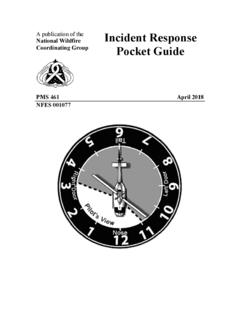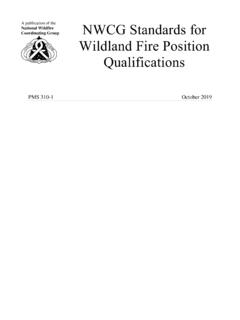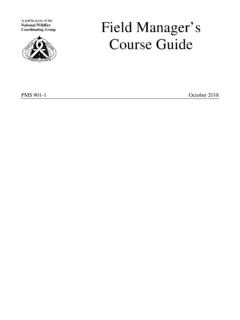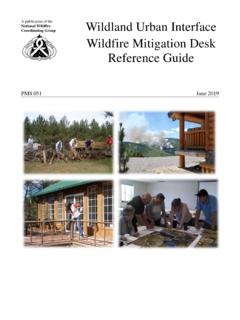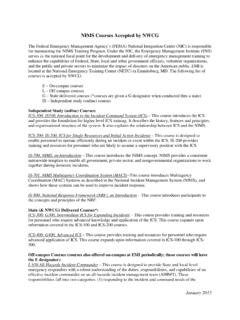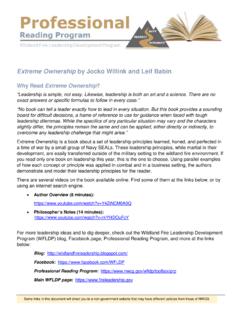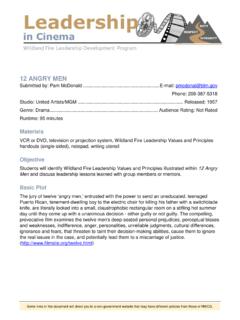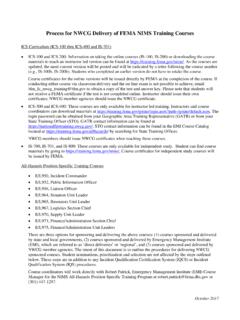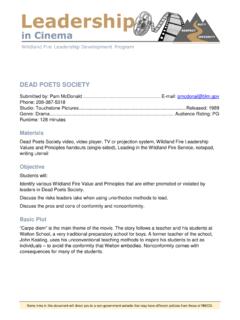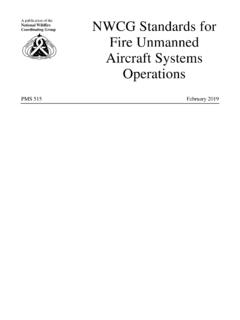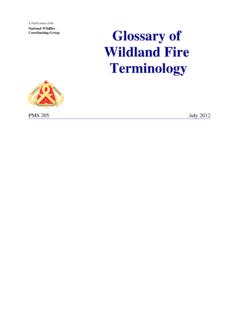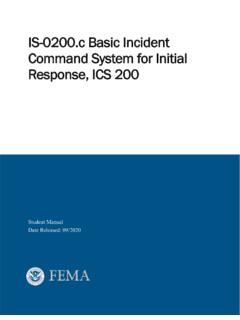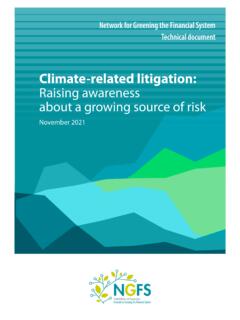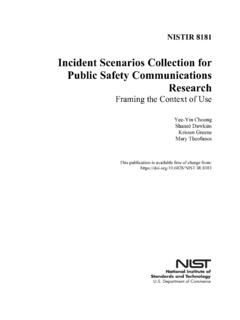Transcription of NWCG Standards for Aviation Transport of Hazardous …
1 A publication of the national Wildfire coordinating group NWCG Standards for Aviation Transport of Hazardous Materials PMS 513 FEBRUARY 2018 The national Wildfire coordinating group (NWCG) provides national leadership to enable interoperable wildland fire operations among federal, state, tribal, territorial, and local partners. NWCG operations Standards are interagency by design; they are developed with the intent of universal adoption by the member agencies. However, the decision to adopt and utilize them is made independently by the individual member agencies and communicated through their respective directives systems. NWCG Standards for Aviation Transport of Hazardous Materials FEBRUARY 2018 PMS 513 The NWCG Standards for Aviation Transport of Hazardous Materials establishes the Standards for the Transport of Hazardous materials in aircraft under the exclusive direction and operational control of federal, state, and local agencies.
2 NWCG Standards for Aviation Transport of Hazardous Materials i Table of Contents Chapter 1 General Information .. 1 Scope .. 1 Objective .. 1 Mandatory vs. Optional Compliance .. 1 Hazmat Employee .. 1 Applicability .. 2 Hazardous material Identification .. 2 Limiting Exposure .. 2 Notification of Pilot-In-Command (NOPIC) of Hazardous Materials .. 2 Pilot-In-Command (PIC) Authority .. 3 Exceptions .. 3 3 Hazardous Communication Marking .. 3 Incompatible Hazardous Materials .. 4 Backhaul .. 4 Training Requirements .. 4 Special 4 Deviations .. 4 Hazardous Materials Mishap Notification .. 4 Chapter 2 Flammable and Combustible Liquids .. 5 General Information .. 5 Control Measures: Non-Bulk .. 5 Control Measures: Flammable Fuel in Powered Equipment Tanks .. 6 Bulk Fuel Containers .. 6 Compatibility 6 Chapter 3 Ignition Devices.
3 7 General Information .. 7 Control Measures .. 7 Compatibility 7 Chapter 4 Batteries/Battery Fluid .. 8 General Information .. 8 Control Measures .. 8 Compatibility 8 Chapter 5 9 General Information .. 9 Control Measures .. 9 Compatibility 9 Chapter 6 Compressed Gases and Liquids .. 10 General Information .. 10 Control Measures .. 10 Compatibility 10 NWCG Standards for Aviation Transport of Hazardous Materials ii Chapter 7 Small Arms Ammunition .. 11 General Information.. 11 Control Measures.. 11 Compatibility 11 Chapter 8 Personal Survival Equipment .. 11 General Information .. 11 Control Measures .. 11 Compatibility 11 Chapter 9 Biomedical Waste .. 12 General Information .. 12 Control Measures .. 12 Compatibility 12 Chapter 10 Bear Repellent/Irritants .. 12 General Information .. 12 Control Measures.
4 12 Compatibility Restrictions .. 12 Appendix 1 .. 13 Appendix 2 .. 16 NWCG Standards for Aviation Transport of Hazardous Materials 1 of 17 Chapter 1 General Information Scope Hazardous material , as defined in 49 CFR, means a substance or material that the Secretary of Transportation has determined is capable of posing an unreasonable risk to health, safety, and property when transported in commerce. The term includes Hazardous substances, Hazardous wastes, marine pollutants, elevated temperature materials, materials designated as Hazardous in the Hazardous Materials Table (see 49 CFR ), and materials that meet the defining criteria for hazard classes and divisions in part 173 of Subchapter C of this chapter. Objective The objective of the Aviation Transport of Hazardous materials program is to ensure the safety of flight when transporting Hazardous materials aboard, including attached to or suspended from (49 CFR (a)) government aircraft under the exclusive direction and operational control of the Department of Interior (DOI) or Forest Service (USFS).
5 DOI or USFS will provide: A. Technical advice on Hazardous materials, handling procedures, and air transportation methods. B. Technical training in the handling, storage, dispensing, and transportation of Hazardous materials. C. Information on innovations and procedures to Transport Hazardous materials. Mandatory vs. Optional Compliance The use of the verb "must" conveys mandatory compliance. The use of "should" conveys required compliance except for documented justifiable reasons. In addition, the use of "may" and "can" convey optional compliance. Hazmat Employee As defined in 49 CFR , a hazmat employee is a person who is employed by a hazmat employer and who in the course of employment directly affects Hazardous materials transportation safety. This term includes an individual, including a self-employed individual, employed by a hazmat employer who, during the course of employment: A.
6 Loads, unloads, or handles Hazardous materials; B. Manufactures, tests, reconditions, repairs, modifies, marks, or otherwise represents containers, drums or packaging as qualified for use in the transportation of Hazardous materials; C. Prepares Hazardous materials for transportation; D. Is responsible for safety of transporting Hazardous materials; or E. Operates a vehicle used to Transport Hazardous material . NWCG Standards for Aviation Transport of Hazardous Materials 2 of 17 Applicability The procedures established in this document will be utilized in the support of DOI and USFS operations involving aircraft that are government-owned and/or contract vendor-owned, flown by either a government or a vendor pilot, under the exclusive direction and operational control of DOI or USFS. Hazardous materials not specified in this document must comply with 49 CFR Parts 171-180.
7 Crew members whose presence is required to perform or is associated with the performance of a governmental function such as national defense, intelligence missions, firefighting, search and rescue, law enforcement (including Transport of prisoners, detainees, and illegal aliens), aeronautical research, or biological or geological resource management are allowed to be aboard an aircraft performing public aircraft operations while transporting Hazardous material (Public Aircraft Operations AC ). Hazardous material Identification Information on the contents of a product suspected of containing Hazardous materials can be obtained by contacting the manufacturer of the product and requesting a Safety Data Sheet (SDS). If a product is suspected of containing Hazardous materials, it must be identified before being transported (Appendix 1). Limiting Exposure Personnel must minimize the hazards associated with transporting Hazardous materials by: A.
8 Carrying Hazardous materials aboard aircraft only when other means of transportation are impracticable. B. Limiting personnel on aircraft carrying Hazardous materials to those crewmembers essential to mission accomplishment. C. Avoiding Hazardous materials flights over populated areas. D. Restraining packages placed aboard aircraft including cargo compartments and external cargo racks from movement while in transit. E. Prohibiting smoking or the use of any item that could cause an open flame or spark when explosives, flammable solids, flammable liquids, or gases are being loaded and unloaded, and during flight. Notification of Pilot-In-Command (NOPIC) of Hazardous Materials A NOPIC must occur using the Hazardous Materials Manifest Form (Appendix 1) to include: 1. Common name, 2. Proper Shipping Name (PSN), 3. Hazard class, 4. Emergency Response Guidebook number, 5.
9 Quantity, and 6. Location of Hazardous materials placed aboard the aircraft. NWCG Standards for Aviation Transport of Hazardous Materials 3 of 17 Notification Standards : 7. Initial: a written NOPIC will be completed during the aircraft pre-use inspection. 8. Daily: load calculations or manifest documentation completed. 9. Verbal: external jettisonable load operations or HAZMAT changes during the mission cycle. The NOPIC will be given to the pilot before the first flight of the day. Thereafter, verbal notification of changes in Hazardous materials is acceptable for ongoing missions. For external jettisonable load operations, verbal notification of the type and quantity of Hazardous materials is acceptable. Pilot-In-Command (PIC) Authority The assigned PIC is directly responsible and is the final authority for the safe operation of the aircraft to include the acceptance of Hazardous materials.
10 Before each flight: A. Inform all personnel of the location of Hazardous materials aboard the aircraft. B. Prohibit any activity that could cause an open flame or sparks. Exceptions Packaging, markings, labeling, and shipping paper requirements of 49 CFR, Subchapter C, do not apply to Hazardous materials transported in accordance with the Standards provided herein when aboard aircraft for government purposes when under exclusive direction and operational control of DOI or USFS. Hazardous materials not specified in this document must be transported in accordance with the requirements of 49 CFR Parts 171-180. Packaging Packages must be inspected for damage or leaks during loading and unloading. Packages with holes, leakage, or other indications of damage affecting integrity must not be placed aboard an aircraft. Damaged or leaking packages discovered on board the aircraft should be handled only as necessary to minimize further damage or injury.
